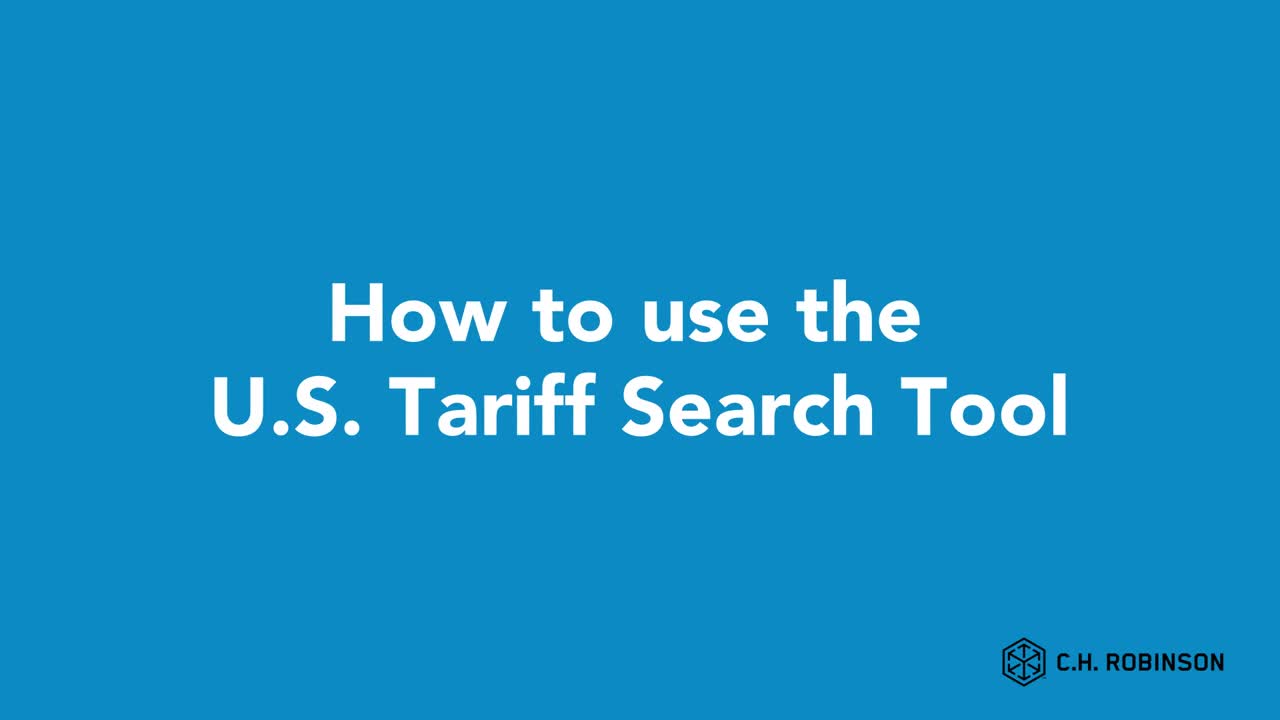
Companies of all sizes have been impacted by the Section 301 China Tariffs that were implemented in 2018 and now affects two-thirds of Chinese origin goods. The following insights will help you determine what the tariffs could mean for your supply chain and what steps to take to maximize your potential duty refunds.
Section 301 China Tariffs: A background
Section 301 of the Trade Act of 1974 authorizes the president to take all appropriate action, not only tariff-based but also non-tariff-based retaliation, to address any unfair act, policy, or practice of a foreign government burdening United States commerce.
The Section 301 China Tariffs were implemented in 2018 after a United States Trade Representative (USTR) investigation into China’s trade practices found that certain Chinese policies and practices were unreasonable or discriminatory and burdened or restricted U.S. companies and workers.
Specifically, the USTR determined from the investigation that China:
- Uses joint venture requirements, foreign investment restrictions, and administrative review and licensing processes to force or pressure technology transfers from U.S. companies to a Chinese entity
- Maintains unfair licensing practices that prevent U.S. companies from getting market-based returns for their intellectual property
- Directs and facilitates investments and acquisitions that generate large-scale technology and IP transfer to support China's industrial policy goals, such as the Made in China 2025 initiative
- Conducts and supports cyber intrusions into U.S. computer networks to gain access to valuable business information
In response to these findings, the United States imposed tariffs—adding 7.5% and 25% to certain products imported from China—amounting to an estimated $173 billion in assessed duties as of January 4, 2023.
The tariffs apply to a broad range of products and have been imposed in four rounds issued as “Lists” on approximately $550 billion of goods imported from China annually.
Section 301 China Tariff Timeline
| Section 301 List | Duty Rate | Effective Date | Import Good Value |
|---|---|---|---|
| List 1 | 25% | July 6, 2018 | $34 billion |
| List 2 | 25% | August 23, 2018 | $16 billion |
| List 3 | 25% | May 10, 2019* | $200 billion |
| List 4a | 7.5% | February 14, 2020** | $300 billion |
| List 4b | Suspended | Suspended** | $300 billion |
*List 3 goods were subject to a 10% duty rate effective September 23, 2018, until they were increased to 25% on May 10, 2019.
**List 4a and 4b goods were subject to a 15% duty rate prior to the United States and China signing the Phase One Economic and Trade Agreement on January 15, 2020, under which List 4a was reduced to 7.5% and List 4b was suspended.
The USTR’s investigation and the imposed tariffs led to the United States and China signing the Phase One Economic and Trade Agreement in January 2020, which included a commitment by China that it would expand the import of various U.S. products and services by no less than $200 billion for the next two years. As a result of the agreement, the duty rate for List 4a goods was reduced from 15% to 7.5%, and List 4b was suspended.
Statutory four-year review
In May 2022, the USTR began the statutory four-year review of the Section 301 actions taken against China. By law, the tariffs expire after four years unless a representative of a domestic industry that benefited from the tariffs submits a written request for continuation.
In October 2022, the USTR announced phase two of the statutory four-year review following requests for continuation from domestic industry representatives, keeping the tariffs in effect until further notice.
As part of the review, the USTR requested public comments from interested parties through January 17, 2023, on “the effectiveness of the actions in achieving the objectives of the investigation, other actions that could be taken, and the effects of such actions on the U.S. economy, including consumers.” The USTR received 1,497 public comments, the majority of which were in favor of removing certain tariffs.
The USTR is now in the process of reviewing the comments received and has the discretion to modify or eliminate the tariffs on entire product lists of specific products. At the time this guide was published, there was no timeline in place for when the review will be completed.
How to seek duty relief and apply duty exclusions
The USTR implemented an exclusion process for the Section 301 tariffs in December 2018 and has since released numerous Section 301 duty exclusions. This opportunity has provided businesses the chance to request an exclusion and/or submit for duty recovery on exclusions that were already available. However, there is ample work involved before duty refunds can be claimed—it’s not just a one-time process.
Some of the steps you may need to take during the exclusion process include:
1. Verify your U.S. HTS classification codes
The Harmonized Tariff Schedule of the United States (HTSUS) governs each exclusion, so you will want to review your 10-digit HTSUS product classification codes as set forth in HTSUS Chapters 1–97 to verify that the affected HTSUS codes are correctly classified.
U.S. Customs and Border Protection (CBP) may deny an exclusion application request where it is found that a product was incorrectly classified.
2. Determine whether your products qualify for any exclusions
Most exclusions are product-specific, meaning your company’s products need to meet the specific USTR descriptions in the corresponding Federal Register Notices. Some exclusions are at the HTSUS-level and may be claimed provided that your product is properly classified.
3. Confirm the tariff exclusion code to apply to your products
Dozens of tariff exclusions continue to be added through detailed Federal Register Notices. Each exclusion is issued a corresponding 8-digit tariff code under Chapter 99 of the HTSUS and is required for duty exemption application in addition to the 10-digit HTSUS code.
4. Know when the exclusions go into effect and expire
Each exclusion has corresponding dates when it goes into effect and expires that you need to keep track of, both for future and past entries. The deadline to apply the exclusions varies depending on different factors, such as the date of the entry and the exclusion being applied.
5. Review previous customs entries to apply the exclusions retroactively
To request refunds on past entries, you may file a Post Summary Correction (PSC) if within the PSC filing timeframe—up to 15 days prior to the scheduled liquidation date, which is generally 300 days from the date of entry summary filing. If the entry is beyond the PSC filing timeframe, you may protest the liquidation if within the protest filing timeframe, which is 180 days following liquidation of the impacted entry.
6. Ensure you have proof of eligibility readily available for the exclusion claims
Shippers requesting refunds for previously paid duties—whether through a PSC or protest—must be able to provide CBP with proof of eligibility (e.g., product literature, descriptive illustrations, product specifications, etc.) should CBP request it. Staying organized is paramount to identifying opportunities and defending against CBP scrutiny.
As you can see, there are many steps and factors to consider during the tariff exclusion process. Without the right data, technology, or expertise, this process can take time to vet out—and that doesn’t include the product-specific exclusions, which account for more than 96% of exclusions and require deeper analysis.
Keep in mind, large refunds are not only for large companies—small and mid-sized businesses can also successfully uncover and submit for large refunds.
Simplify the tariff process with the right resources
1. Find potential duty exclusions
To see if any exclusions apply to your products, get an easy-to-understand report from our free U.S. Tariff Search Tool. With help from the tool, you can gain clarity on import costs and identify potential opportunities to reduce or eliminate duties and fees. See how easy it is to get started with the U.S. tariff search tool—it takes less than a minute.

2. Track Section 301 duty spend and potential savings over time
You can quickly and easily see what exclusions you have claimed with our U.S. Customs Analytics tool in Navisphere®.
It’s easy to see at the invoice line or SKU-level and identify how much you owed in additional duty under the Section 301 China Tariffs and other additional duties, such as the Section 232 steel/aluminum tariffs. You can also determine how renewal or expiration of these exclusions will impact your landed costs.
3. Obtain tariff classification and origin review assistance
Do you know how your goods are made—from raw materials to finished goods—by whom and where? Many companies are still adapting their supply chains and manufacturing processes when it comes to Section 301 tariffs. If you’re looking to move manufacturing and/or assembly processes in hopes of averting Section 301 tariffs, consider submitting a binding ruling to definitively confirm the last country where the substantial transformation of goods occurs.
Because verifying your HTSUS product classifications is an important step in the tariff exclusion process, you may need assistance reviewing, classifying, or obtaining a binding ruling for your products. Get in touch with our dedicated classification team to help determine the correct HTSUS classification for a product and if the classification results in fewer duties owed, if any.
4. Stay informed
Changes to the Section 301 China Tariffs and exclusions are ongoing and complex. Subscribe to our Client Advisories to be among the first to know when changes take place.
Connect with one of our Trusted Advisor® experts for personalized help navigating the Section 301 tariffs and exclusion process.